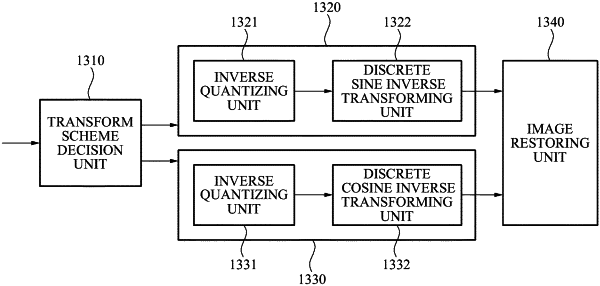| CPC G06T 9/007 (2013.01) [G06T 9/004 (2013.01); H04N 7/17318 (2013.01); H04N 19/12 (2014.11); H04N 19/147 (2014.11); H04N 19/19 (2014.11); H04N 21/236 (2013.01); H04N 19/132 (2014.11); H04N 19/149 (2014.11); H04N 19/46 (2014.11); H04N 19/70 (2014.11)] | 5 Claims |

|
1. A method for decoding an image, the method comprising:
determining a set of scaling factors for inverse-quantizing transform coefficients of a current block based on a size of the current block;
inverse-quantizing the transform coefficients of the current block based on the set of scaling factors and a quantization variable given by dividing a quantization parameter by a pre-determined constant value;
determining whether or not to perform an inverse-transform process;
deciding an inverse-transform scheme with respect to the transform coefficients of the current block as one of discrete cosine transform (DCT) and discrete sine transform (DST); and
generating a decoded image based on the inverse-quantized transform coefficients according to the decided inverse-transform scheme,
wherein the inverse-quantizing is performed based on multiplying each of the transform coefficients of the current block to a corresponding scaling factor among the set of scaling factors and left-shifting a result of the multiplication of the each of the transform coefficients with the corresponding scaling factor,
wherein the set of scaling factors is determined by selectively using one of a first predefined table from which one or more first candidate tables for a 4×4 block are derivable, each of the one or more first candidate tables for the 4×4 block specifying sixteen explicit integer values mapping one-to-one for sixteen locations in the 4×4 block and a second predefined table from which one or more second candidate tables for an 8×8 block are derivable, each of the one or more second candidate tables for the 8×8 block specifying sixty four explicit integer values mapping one-to-one for sixty four locations in the 8×8 block according to the size of the current block, each of the first candidate tables comprises ‘n’ distinct values, ‘n’ being smaller than 16, each of the second candidate tables comprises ‘m’ distinct values, ‘m’ being smaller than 64, and ‘n’ being smaller than ‘m’.
|